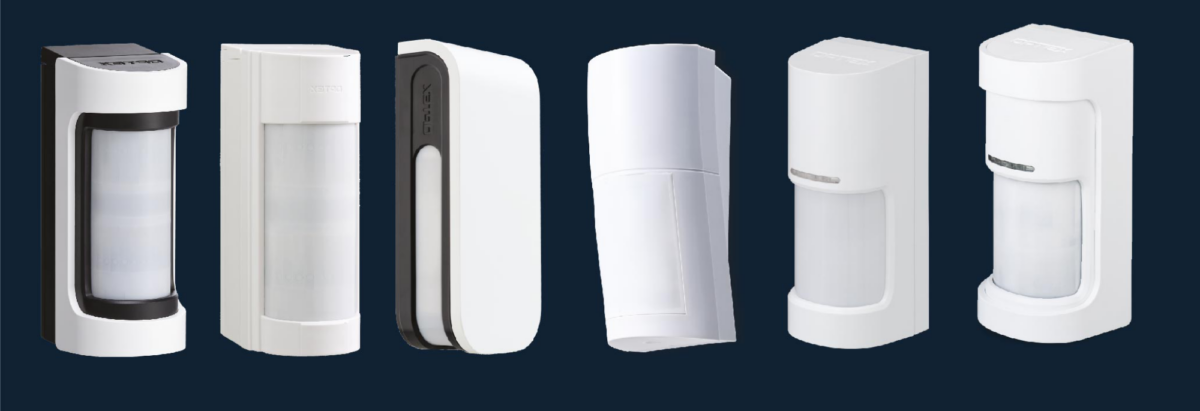27 July 2022 - Elitsa Dobreva
Featured in: Market Insights, Intrusion detection
PIR sensors detect movement by capturing the infrared radiation emitted by people or objects in the specified area and measuring the change in temperature. For any sensor to be effective, it is important that it provides reliable detection that can be trusted to secure residential, commercial, or industrial sites.

Although there are many variations of PIR sensors, there is something that installers, system integrators and end users can agree on: a high capture rate and low false alarm rates.
Factors to look for in a good PIR sensor

Digital logic
There are many environmental challenges, particularly outdoors, such as weather, small animals and nearby vegetation which could confuse detectors and create false alarms.
PIR sensors equipped with digital logic such as our unique SMDA (Super Multi-Dimensional Analysis) ensure that PIRs have advanced sensitivity and precision, creating an ‘intelligent detection’. The sensors use digital microprocessors with customized algorithms and analysis which provide the detector with intelligence to recognise its environment and distinguish genuine intrusions. An example of how this works can be seen in our pet tolerant sensors, where the digital logic allows the sensor to better analyse the passive infrared signals and not recognise small pets, lowering false alarms.

Lens quality
The lens of a detector can be fundamental to its efficiency and is used to create optical windows which control the PIR’s detection area, zone size and sensitivity. Generally, there are three main types of lenses: flat, spherical and mirror.
In indoor sensors for instance, the use of a spherical Fresnel lens is the best technical choice. The advantage of a spherical lens is that each segment is precisely positioned according to its required detection pattern, at a uniform distance from the pyroelectric element. This then eliminates sensitivity distortion and achieves a sharper focus of object targets..

Microwave module
In dual technology detectors (PIR + microwave technologies) the quality of the microwave module is crucial to high performance detection and the use of gold antennas to prevent corrosion and signal deterioration make sensors not only more effective but more durable especially in hot and humid climates.
Another important aspect of microwave sensors is the detection range, which should be tailored to the IR sensor to provide better capture performance and mitigate false alarms. This can be an issue for many X-band microwave sensors and can be solved with our Tough MOD 2.

Ability to customise detection range
In order to prevent the detection area from crossing over into public areas, which would generate multiple false alarms, a good PIR should allow the detection range to be customised. For instance, with our PIR a detection range of up to 12m can be adjusted to suit the area to be protected by offering five detection range options: 2.5m, 3.5m, 6m, 8.5m or 12m.

Ease of installation
The installation of the detector is perhaps the most important stage as its fundamental that the detector is installed correctly and with precision to avoid potential false alarms. To ease installation, we provide the ‘blue touch’ in our Shield and WX models which means all configuration parts are coloured in blue so they can easily be identified by the installer. Also, the Shield series offers a screw free design and built-in level indicator to save time on installation..

Wireless
Depending on the location where the sensors need to be installed, it is possible to use wireless detectors. Nearly all of our sensors allow seamless integration with most wireless panel manufacturers and bi-directional communication which gives the flexibility to remotely configure the sensor, for example to adjust to the environment. Our wireless sensors also have excellent battery life, lasting between 3-5 years on average.

Design & aesthetic
The design and appearance of a sensor can also play an important role when it comes to making your decision. Our PIR sensors are designed with a sleek, modern and clean finish so that they can fit nicely with their surroundings whether it be in a home, commercial centre, warehouse or office. We also realize that in some sites it is important to make sure that the sensor can blend in with its environment, both for security or aesthetic reasons, which is why we offer a custom painting option while also making sure that they are as compact and discreet as possible.
For more info on our custom paint jobs contact us here.
Durability
Testing is a vital stage of the manufacturing process of any intrusion detector, it is proof of the advanced quality level and durability. At OPTEX we take this very seriously and our sensors undergo 150 different tests to guarantee their optimal operation in all seasons and weather conditions and that they will withstand the test of time.
When it comes to durability, the quality of components also plays an important role. The cover of the detector will support its resistance, particularly in the outdoor environment where it is exposed to adverse elements. The use of ASA components has been proven to be the most effective for outdoor detectors due to its ability to withstand the harshness of the weather and possible vandalism attempts.


